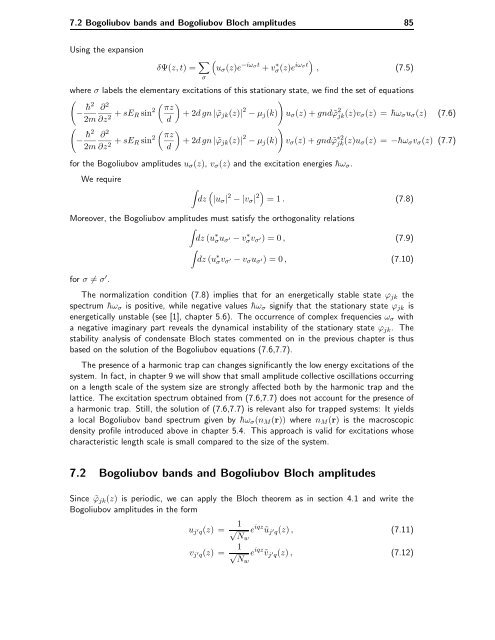Bose-Einstein Condensates in Rotating Traps and Optical ... - BEC
Bose-Einstein Condensates in Rotating Traps and Optical ... - BEC
Bose-Einstein Condensates in Rotating Traps and Optical ... - BEC
You also want an ePaper? Increase the reach of your titles
YUMPU automatically turns print PDFs into web optimized ePapers that Google loves.
7.2 Bogoliubov b<strong>and</strong>s <strong>and</strong> Bogoliubov Bloch amplitudes 85<br />
Us<strong>in</strong>g the expansion<br />
δΨ(z,t) = <br />
σ<br />
<br />
uσ(z)e −iωσt + v ∗ σ(z)e iωσt<br />
, (7.5)<br />
where σ labels the elementary excitations of this stationary state, we f<strong>in</strong>d the set of equations<br />
<br />
− ¯h2 ∂<br />
2m<br />
2<br />
∂z2 + sER s<strong>in</strong> 2<br />
<br />
πz<br />
+2dgn| ˜ϕjk(z)|<br />
d<br />
2 <br />
− µj(k) uσ(z)+gnd˜ϕ 2 jk(z)vσ(z) =¯hωσuσ(z) (7.6)<br />
<br />
− ¯h2 ∂<br />
2m<br />
2<br />
∂z2 + sER s<strong>in</strong> 2<br />
<br />
πz<br />
+2dgn| ˜ϕjk(z)|<br />
d<br />
2 <br />
− µj(k) vσ(z)+gnd˜ϕ ∗2<br />
jk(z)uσ(z) =−¯hωσvσ(z) (7.7)<br />
for the Bogoliubov amplitudes uσ(z), vσ(z) <strong>and</strong> the excitation energies ¯hωσ.<br />
We require<br />
<br />
dz |uσ| 2 −|vσ| 2<br />
=1. (7.8)<br />
Moreover, the Bogoliubov amplitudes must satisfy the orthogonality relations<br />
<br />
dz (u ∗ σuσ ′ − v∗ σvσ ′)=0, (7.9)<br />
<br />
dz (u ∗ ′ σvσ − vσuσ ′)=0, (7.10)<br />
for σ = σ ′ .<br />
The normalization condition (7.8) implies that for an energetically stable state ϕjk the<br />
spectrum ¯hωσ is positive, while negative values ¯hωσ signify that the stationary state ϕjk is<br />
energetically unstable (see [1], chapter 5.6). The occurrence of complex frequencies ωσ with<br />
a negative imag<strong>in</strong>ary part reveals the dynamical <strong>in</strong>stability of the stationary state ϕjk. The<br />
stability analysis of condensate Bloch states commented on <strong>in</strong> the previous chapter is thus<br />
based on the solution of the Bogoliubov equations (7.6,7.7).<br />
The presence of a harmonic trap can changes significantly the low energy excitations of the<br />
system. In fact, <strong>in</strong> chapter 9 we will show that small amplitude collective oscillations occurr<strong>in</strong>g<br />
on a length scale of the system size are strongly affected both by the harmonic trap <strong>and</strong> the<br />
lattice. The excitation spectrum obta<strong>in</strong>ed from (7.6,7.7) does not account for the presence of<br />
a harmonic trap. Still, the solution of (7.6,7.7) is relevant also for trapped systems: It yields<br />
a local Bogoliubov b<strong>and</strong> spectrum given by ¯hωσ(nM(r)) where nM(r) is the macroscopic<br />
density profile <strong>in</strong>troduced above <strong>in</strong> chapter 5.4. This approach is valid for excitations whose<br />
characteristic length scale is small compared to the size of the system.<br />
7.2 Bogoliubov b<strong>and</strong>s <strong>and</strong> Bogoliubov Bloch amplitudes<br />
S<strong>in</strong>ce ˜ϕjk(z) is periodic, we can apply the Bloch theorem as <strong>in</strong> section 4.1 <strong>and</strong> write the<br />
Bogoliubov amplitudes <strong>in</strong> the form<br />
uj ′ q(z) = 1<br />
√ e<br />
Nw<br />
iqz ũj ′ q(z) , (7.11)<br />
vj ′ q(z) = 1<br />
√ e<br />
Nw<br />
iqz ˜vj ′ q(z) , (7.12)




